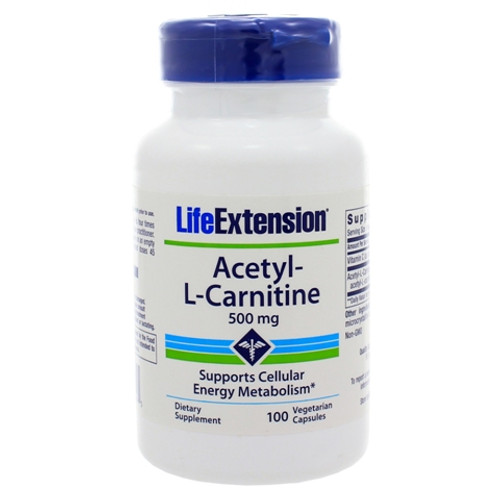A major cause of aging is a reduction in the energy-producing components of the cell, resulting in reduced cellular metabolic activity, and the accumulation of cellular debris.1-7 L-carnitine helps maintain cellular energy metabolism by assisting in the transport of fatty acids from the cytosol into the mitochondria within the cell, where fats are oxidized to produce the cellular energy (adenosine triphosphate or ATP).8-13
Acetyl-L-carnitine is the acetylated ester of the amino acid L-carnitine. Acetyl-L-carnitine is an endogenous mitochondrial membrane compound that helps maintain mitochondrial bioenergetics and lowers the increased oxidative stress associated with aging.14 Acetyl-L-carnitine and L-carnitine are absorbed into the bloodstream efficiently. Both are effective at carrying long-chain fatty acids across the membrane into the mitochondria where they are burned for energy production and utilized efficiently by the cells.15-18 Acetyl-L-carnitine also crosses the blood-brain barrier and guards against oxidative damage.5, 14, 19-21 Amyloid-beta peptide is a principal component of plaques and is thought to be a contributor to the aging process. Acetyl-L-carnitine exerts protective effects against such neurotoxicity and oxidative stress.14
Acetyl-L-carnitine (ALC) easily crosses the blood-brain barrier and may have potential in exerting unique neuroprotective, neuromodulatory and neurotrophic properties. ALC may support youthful memory function, improve mitochondrial structure and function, inhibit age-related oxidative damage, and restore the activity of key enzymes.22-28
References
1. Physiol Rev.1998 Apr;78(2):547-81.
2. Ann N Y Acad Sci. 2004 Jun;1019:406-11.
3. Trends Cell Biol. 2011 Oct;21(10):569-76.
4. Zhonghua Yi Xue Za Zhi (Taipei). 2001 May;64(5):259-70.
5. Am J Physiol Cell Physiol. 2007 Feb;292(2):C670-86.
6. Proc Natl Acad Sci U S A. 1997 Apr 1;94(7):3064-9.
7. Ann N Y Acad Sci. 1998 Nov 20;854:118-27.
8. J Lipid Res. 2004 Apr;45(4):729-35.
9. Metabolism. 1997 Dec;46(12):1454-7.
10 Mech Ageing Dev. 1995 Oct 13;84(2):103-12.
11. Ann N Y Acad Sci. 2002 Apr;959:491-507.
12. Biochim Biophys Acta. 2000 Jun 26;1486(1):1-17.
13. Am J Clin Nutr. 2007 Dec;86(6):1738-44.
14. J Neurosci Res. 2006 Aug 1;84(2):398-408.
15. Acta Diabetol. 2003 Oct;40 Suppl 1:S106-13.
16. Biochim Biophys Acta. 2000 Jun 26;1486(1):1-17.
17. Clin Pharmacokinet. 2012 Sep 1;51(9):553-72.
18. Exp Physiol. 2008 Oct;93(10):1139-46.
19. Neurochem Res. 2009 Apr;34(4):755-63.
20. Ann N Y Acad Sci. 2004 Nov;1033:117-31.
21. Proc Natl Acad Sci U S A. 2002 Feb 19;99(4):1876-81. Erratum in: Proc Natl Acad Sci U S A 2002 May 14;99(10):7184.
22. Neurochem Res. 2003 Sep;28(9):1321-8.
23. Ann N Y Acad Sci. 2004 Nov;1033:108-16..
24. Geriatr Gerontol Int. 2010 Jul;10 Suppl 1:S99-106
25. Neuropharmacology. 2008 Aug;55(2):223-9.
26. Arch Gerontol Geriatr. 2008 Mar-Apr;46(2):181-90
27. Eur J Pharmacol. 2007 Sep 10;570(1-3):97-107.
28. Brain Res. 2005 Nov 9;1061(2):114-7.








